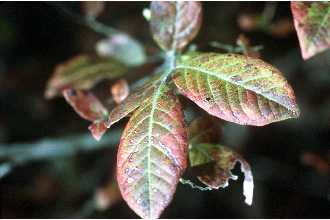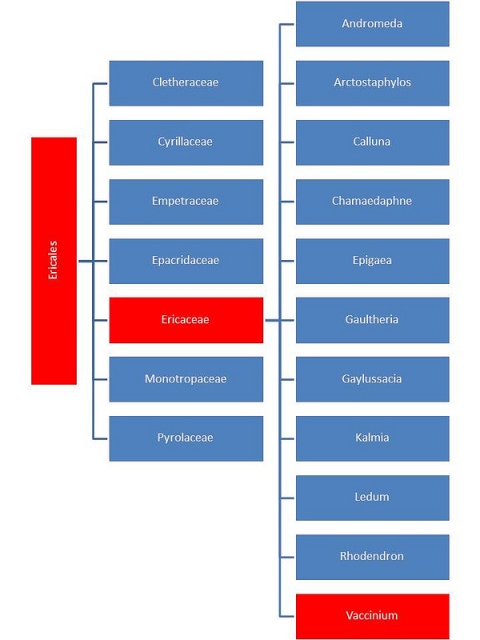Classifying Vaccinium corymbosum
Domain: Eukarya
The Eukarya are organisms that have membranous organelles in their cell(s). They all have a nucleus surrounded by a nuclear envelope.
Members of the kingdom Plantae have several characteristics that set them apart from other kingdoms. Most plants are autotrophic. Their cells contains cellulose cell walls, chloroplast, and chlorophyll. All plants undergo an alteration of generations between a haploid phase and a diploid phase.
Sub-kingdom: Tracheobionta
The phylum Tracheobionta are vascular plants. Vascular plants have special tissue, xylem and phloem, specifically for transporting water and nutrients.
Phylum: Magnoliophyta
The Magnoliophyta are also called angiosperms. They are the flowering plants. They all produce flowers that contain an ovary in which the seeds develop, and the ovary becomes the fruit. The fruit serves as protection for the seed and as a dispersal mechanism.
Class: Magnoliopsida
This class is also referred to as the dicotyledons (dicots). The defining attribute of the dicotyledons is that their embryos have have cotyledons; in other words, the seeds are sectioned down the middle so they can easily be broken in half.
Order: Ericales
The order Ericales includes a wide variety of dicotyledons that range from autotrophic to carnivorous (genus Sarracenia). Some common members include tea plants and Brazil nuts.
Family: Ericaceae
Members of the Ericaceae family are also called the heaths. Ericaceae are woody plants that grow in acidic soils. Ericaceae include some small trees, shrubs, and bushes.
Genus: Vaccinium
This genus includes blueberries (including
lowbush blueberries), huckleberries, and
cranberries. The name of this phylum is based on appearance of
the berry. As mentioned on the first page, Vaccinium is
the ancient Latin word for 'bilberry.' All of the members of this
genus have fruit that resembles a bilberry. The Vaccinium genus is divided into two
subgenera: Oxycoccus (cranberries, which have thinner shoots)
and Vaccinium (all other members of the Vaccinium
genus, with thicker, woody shoots). Vaccinium corymbosum
belongs to the Vaccinium subgenus. These two subgenera
are further broken down into sections.
Species: Vaccinium corymbosum
Also known as the highbush
blueberry!
Phylogeny of Ericales order
The order Ericales is divided into families on physiological features. For example, the family Ericaceae is also known as the lime-haters (meaning they don't do will in soils with a high alkalinity), and also prefer acidic soils.
More information on the classification of the
Ericales order can be found on the
United States Department of Agriculture website.
Phylogeny of Vaccinium subgenera
The genus Vaccinium is divided into two subgenera based on physical appearance. Members of the subgenus Oxycoccus are cranberries and have "slender, trailing, wiry non-woody shoots and strongly reflexed flower petals" (Absolute Astronomy). Members of the Vaccinium subgenera woody shoots that are thicker than those of the Oxycoccus, and have upright, bell-shaped flowers.

**Note that the list of species under the section
Cyanococcus is not a complete list.
More information on the classification of the Vaccinium genus can be found at absoluteastronomy.com.
Find out where the highbush blueberry grows best on my
Habitat page!
Return to homepage



